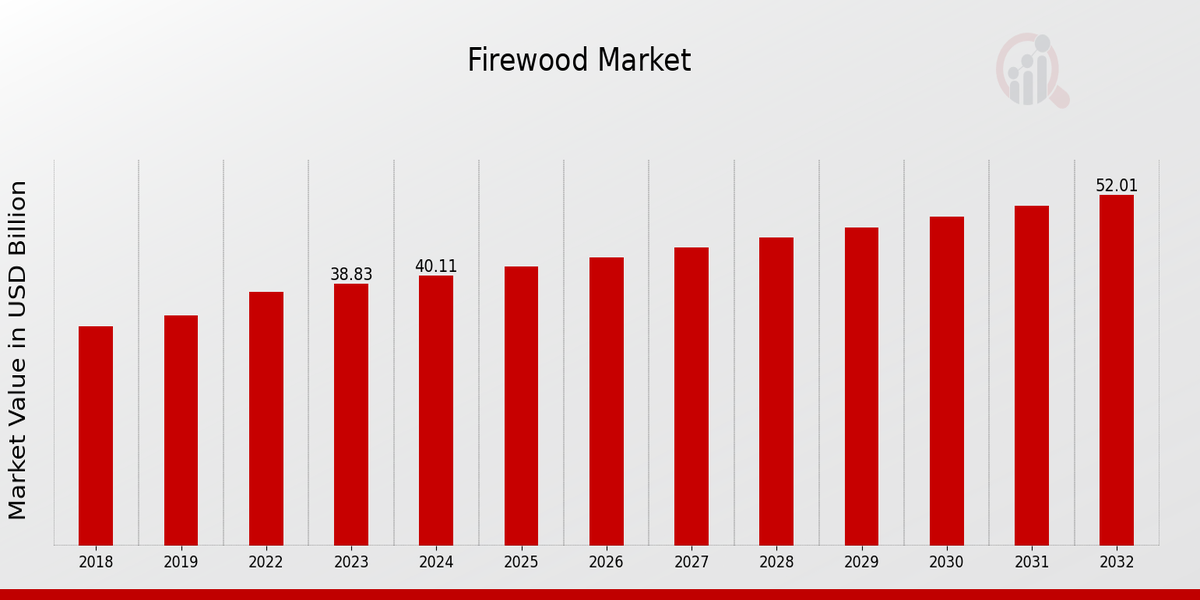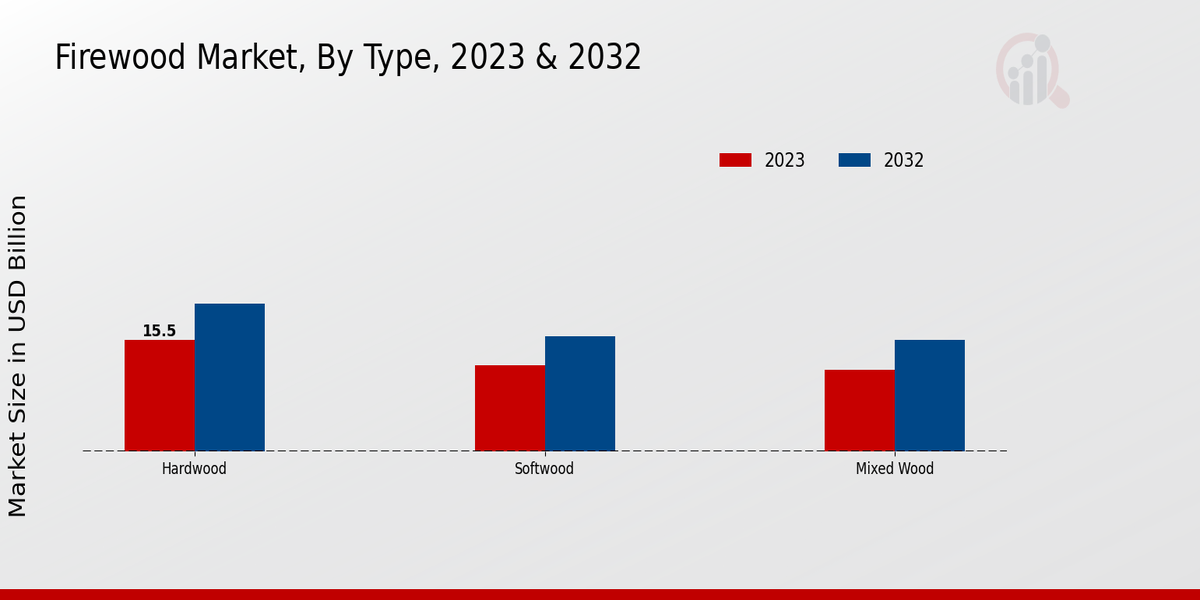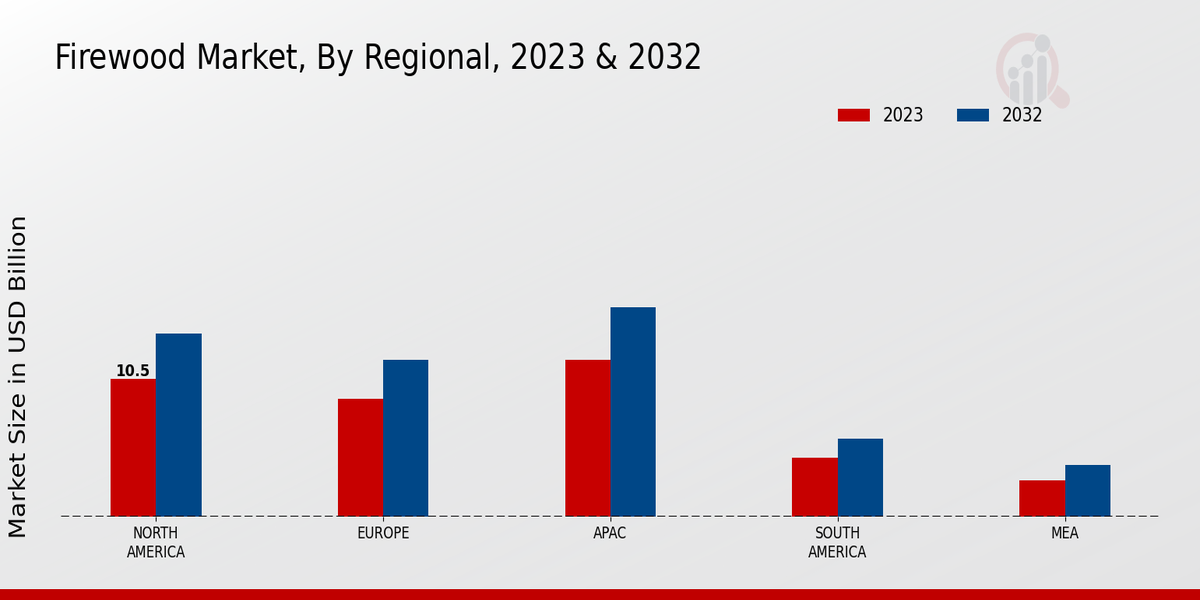Global Firewood Market Overview
Firewood Market Size was estimated at 37.59 (USD Billion) in 2022. The Firewood Market Industry is expected to grow from 38.83(USD Billion) in 2023 to 52.0 (USD Billion) by 2032. The Firewood Market CAGR (growth rate) is expected to be around 3.3% during the forecast period (2024 - 2032).

Source Primary Research, Secondary Research, MRFR Database and Analyst Review
Key Firewood Market Trends Highlighted
The demand for renewable energy sources is significantly driving the firewood market. As consumers increasingly prioritize eco-friendly options and look for alternatives to fossil fuels, firewood stands out as a sustainable choice. Additionally, the rising popularity of outdoor activities and heating solutions in rural areas further contributes to market growth. People are drawn to firewood not only for its cost-effectiveness but also for its environmentally friendly attributes. This shift towards greener energy solutions is encouraging more sustainable sourcing practices and enhancing overall market appeal. There are numerous opportunities to explore in the firewood market, especially as more consumers seek out organic and locally sourced products.The growing interest in biomass energy offers avenues for innovation, such as the development of processed firewood products that cater to varying consumer preferences. Manufacturers can capitalize on the trend of DIY home heating solutions and outdoor fire pits, creating niche offerings that attract a broader audience. Moreover, partnerships between suppliers and retailers can enhance distribution reach and tap into new markets. The transition towards sustainable practices can also lead to creating new markets for certified firewood. In recent times, sustainability has been at the forefront of market trends, with an increasing emphasis on responsible sourcing and environmental impact.The rise of urbanization has led to a growing interest in alternative heating solutions in metropolitan areas, where consumers are becoming more aware of their carbon footprints. The integration of technology in the firewood industry, such as apps for sourcing and purchasing firewood, reflects the trend towards convenience and accessibility. Moreover, as governments and organizations promote renewable energy initiatives, the firewood market is likely to witness a boost, aligning with sustainability goals. This convergence of interest in eco-friendly solutions and consumer convenience is shaping the future landscape of the firewood market.
Firewood Market Drivers
Increasing Demand for Clean and Renewable Energy Sources
The growing focus on sustainability and reducing carbon emissions has significantly boosted the demand for clean and renewable energy sources. As concerns over environmental impact and climate change rise, more households and businesses are seeking alternative heating options that lower their carbon footprint. Firewood serves as an accessible and sustainable resource for energy, particularly in rural areas where access to traditional energy sources may be limited.The Firewood Market Industry is experiencing a shift as consumers increasingly prefer wood-burning stoves and fireplaces. This trend is particularly evident in regions where there is an abundant supply of biomass. Moreover, government initiatives and policies promoting renewable energy further incentivize the use of firewood as an eco-friendly heating option. These factors combined mean that sustainable practices, such as responsible sourcing and eco-certification, will continue to shape the trajectory of the Firewood Market significantly.In addition to environmentally conscious consumers, the residential sector, which often seeks efficient heating solutions at lower costs, also drives this market. Overall, as technological advancements improve wood burning efficiency and safety, and as awareness of responsible and renewable energy sources continues to grow, the demand for firewood is expected to rise markedly in the foreseeable future.
Rising Energy Prices
The Firewood Market Industry is significantly influenced by fluctuations in conventional energy prices. As the costs of electricity, oil, and natural gas continue to rise, many consumers are looking for cost-effective alternatives for heating their homes. Firewood provides an economical solution, allowing households and small businesses to save on energy expenses, especially during the colder months. This economic aspect is particularly appealing to those in rural and semi-urban areas, where the availability of firewood can translate to substantial savings.
Cultural and Traditional Uses of Firewood
Cultural practices and traditions that involve the use of firewood are prevalent in many parts of the world. The Firewood Market Industry benefits greatly from these customs, as they not only contribute to the demand for firewood for cooking and heating but also preserve unique cultural heritages. Events such as barbecues, bonfires, and traditional ceremonies remain popular, which sustains the use of firewood in many cultures. This driver highlights the interconnection between cultural significance and market growth, emphasizing the resilient demand for firewood.
Firewood Market Segment Insights
Firewood Market Type Insights
The Firewood Market, valued at 38.83 USD Billion in 2023, presents a diverse landscape when examining its types, including Hardwood, Softwood, and Mixed Wood players. This segmentation reflects the preferences and needs for various uses, including heating and cooking, which drive significant demand across different geographical regions. Hardwood holds a majority share within the overall market, valued at 15.5 USD Billion in 2023, and is projected to grow to 20.5 USD Billion by 2032. Its dense composition makes it ideal for longer burning times and higher heat output, which appeals to both residential and commercial users.This sub-segment’s dominance can be attributed to the increased demand for efficient and sustainable energy sources. Conversely, the Softwood segment is valued at 12.0 USD Billion in 2023, expected to reach 16.0 USD Billion by 2032. Softwood is favored for its quick ignition and ease of burning, making it a popular choice among consumers seeking convenience for immediate use, despite generally lower heating values compared to hardwood. Meanwhile, the Mixed Wood category, valued at 11.33 USD Billion in 2023 and anticipated to grow to 15.5 USD Billion by 2032, offers a balanced option by combining characteristics of both hardwood and softwood, catering to consumers who prefer variety and flexibility.The Firewood Market segmentation illustrates a robust demand that is driven by trends towards renewable energy and sustainable practices, thus creating avenues of opportunity for growth in producing and distributing various types of firewood ly. As market growth continues, understanding the dynamics of each type is crucial for stakeholders looking to capitalize on the shifts in consumer preferences and increasing environmental awareness. This segmentation not only highlights market valuations but also emphasizes the growing significance of each category in the evolving energy landscape.

Source Primary Research, Secondary Research, MRFR Database and Analyst Review
Firewood Market Application Insights
The Firewood Market is anticipated to reach a valuation of 38.83 billion USD in 2023, showing a steady interest in various applications such as Residential Heating, Commercial Heating, Cooking, Outdoor Fireplaces, and Industrial Applications. Among these, residential heating dominates significantly as people increasingly opt for cost-effective and eco-friendly heating solutions. Cooking also plays a vital role, especially in regions where traditional wood-fired ovens are preferred for their flavor-enhancing properties. The outdoor fireplaces segment continues to gain traction, catering to homes looking to enhance outdoor living spaces, while commercial heating addresses the needs of businesses seeking sustainable heating alternatives.Industrial applications are increasingly recognized for their efficiency in biomass energy utilization. Overall, the Firewood Market data indicates a growing trend towards renewable energy sources, supported by rising consumer awareness of the environmental impact and cost savings associated with firewood use. Alongside these developments, market growth faces challenges such as sustainability concerns and the availability of quality wood, providing an ongoing opportunity for innovations in the sector that align with eco-friendly practices.
Firewood Market Form Insights
The Firewood Market, valued at 38.83 USD Billion in 2023, is experiencing notable growth across its various forms, such as logs, wood pellets, chips, kindling, and bundles. This market exhibits a steady upward trajectory, driven by increasing demand for sustainable and eco-friendly heating solutions. Each form serves distinct purposes; for instance, logs are often favored for traditional heating methods, while wood pellets present an efficient option for modern stoves and boilers. Chips play a crucial role in industrial applications, providing biomass energy, while kindling and bundles are essential for easy fire-starting in residential settings.The segmentation of the Firewood Market showcases diverse consumer preferences influencing market dynamics and usage patterns. Furthermore, shifts toward renewable energy sources and declining fossil fuel dependence continue to drive market growth alongside challenges such as fluctuating prices and supply chain complexities. As the market evolves, there remain significant opportunities for innovation within the firewood segment, catering to the growing segment of environmentally conscious consumers. Overall, the Firewood Market statistics reflect robust demand and adaptability amid changing energy landscapes.
Firewood Market Distribution Channel Insights
The Firewood Market revenue is experiencing notable dynamics through its Distribution Channel segment, which includes Retail Stores, Online Sales, and Wholesale Distributors. As of 2023, the market is valued at 38.83 billion USD, reflecting a steady demand for firewood across various user segments, including residential and commercial sectors. Retail Stores play a pivotal role in catering to local communities, providing the convenience and immediacy that consumers often seek. Meanwhile, Online Sales have emerged as a significant channel, driven by increasing digitalization and consumer preference for the ease of online shopping.This shift has presented ample opportunities for companies to enhance their market reach. Wholesale Distributors also dominate this landscape by efficiently supplying large volumes to retailers, ensuring consistent availability. The interplay of these channels is crucial for the overall growth of the Firewood Market industry, as each serves distinct consumer needs and preferences, ultimately driving the market growth. The Firewood Market statistics indicate that expanding distribution networks and evolving consumer behaviors will likely shape the competitive landscape in the coming years.
Firewood Market Regional Insights
The Firewood Market is projected to be valued at 38.83 USD Billion in 2023, demonstrating a diverse geographical segmentation that contributes significantly to its overall performance. North America holds a dominant position within this market, valued at 10.5 USD Billion, driven by strong demand for sustainable energy sources and outdoor activities, which results in a substantial market presence. Europe follows closely, with a valuation of 9.0 USD Billion, where regulations supporting renewable energy further boost its importance. Meanwhile, the APAC region, valued at 12.0 USD Billion, showcases significant growth potential due to increasing urbanization and a rising preference for firewood as a cost-effective energy solution.South America, while smaller at 4.5 USD Billion, plays a vital role in the market due to growing environmental awareness and local practices of using firewood for heating. The Middle East and Africa (MEA) segment, at 2.8 USD Billion, lags behind, often facing challenges such as limited infrastructure but presents unique opportunities for development in regions seeking alternative energy sources. The varied dynamics across these regions illustrate the complexity and richness of the Firewood Market landscape.

Source Primary Research, Secondary Research, MRFR Database and Analyst Review
Firewood Market Key Players and Competitive Insights
The Firewood Market has witnessed significant growth driven by increasing demand for sustainable energy sources and a resurgence in the use of traditional fuels for heating and cooking, particularly in rural areas and developing countries. This market's competitive landscape is characterized by a mix of established players and new entrants, all vying for market share while seeking to differentiate their products through quality and sustainability practices. Key factors influencing competition include pricing strategies, distribution networks, and effective marketing practices aimed at promoting the eco-friendly attributes of firewood. The competitive insights also reveal a trend towards innovation in packaging and product freshness, with companies increasingly focusing on customer preferences for convenience and quality, thereby enhancing their competitive edge.Smith Forest Products has carved out a strong presence in the Firewood Market thanks to its commitment to sustainable sourcing and quality assurance. The company has developed a reputation for offering premium firewood that adheres to strict quality control measures, ensuring consistency and reliability in its products. Smith Forest Products leverages its extensive distribution channels to reach a broad customer base, encompassing both residential and commercial markets. The company’s strength lies in its ability to respond to changing market demands with agility, allowing it to maintain a competitive advantage over peers. Its focus on customer service enhances its market position, as it builds lasting relationships with clients who value reliability and quality.Pinnacle Renewable Energy is another significant player in the Firewood Market, focusing on the production and distribution of wood pellets and firewood products. The company emphasizes environmentally responsible practices, utilizing renewable resources and advanced technology to optimize production efficiency while minimizing waste. Pinnacle Renewable Energy invests heavily in research and development to innovate its product offerings and expand its market reach. Its strong commitment to sustainability enhances its brand reputation, appealing to environmentally conscious consumers. The company has established a vast distribution network that allows it to serve diverse markets effectively, thus creating a robust competitive foothold in the industry while catering to the growing preference for cleaner energy solutions.
Key Companies in the Firewood Market Include
- Smith Forest Products
- Pinnacle Renewable Energy
- Maine Woods Company
- Burgess BioPower
- Finnish Forest Industries
- Appalachian Forest Products
- Drax Group
- Green Circle Bio Energy
- West Fraser Timber
- The Woodpile
- The Wood Yard
- Hakala Wood Products
- Enviva
- WoodCo
Firewood Market Industry Developments
Recent developments in the Firewood Market have shown a growing focus on sustainability and renewable energy. Companies such as Pinnacle Renewable Energy and Drax Group are leading the way in promoting environmentally friendly practices, aiming to reduce their carbon footprint while meeting the increasing demand for biomass energy. Maine Woods Company and Burgess BioPower have recently expanded their operations to enhance wood pellet production, aligning with efforts to transition to cleaner energy sources. Finnish Forest Industries is actively involved in enhancing wood processing techniques to increase efficiency. In the realm of mergers and acquisitions, companies like Enviva have made strategic moves to bolster their market presence, although no specific acquisitions involving the mentioned companies have been publicly reported recently. The market valuation for companies like Smith Forest Products, West Fraser Timber, and Appalachian Forest Products is on the rise, driven by heightened demand for renewable resources and government incentives for sustainable practices. As consumer preferences shift towards eco-friendly options, the firewood market continues to evolve, reflecting the broader trends in the renewable energy landscape. WoodCo and Green Circle Bio Energy are also adapting to market changes, making strides in operational improvements.
Firewood Market Segmentation Insights
- Firewood Market Type Outlook
- Hardwood
- Softwood
- Mixed Wood
- Firewood Market Application Outlook
- Residential Heating
- Commercial Heating
- Cooking
- Outdoor Fireplaces
- Industrial Applications
- Firewood Market Form Outlook
- Logs
- Wood Pellets
- Chips
- Kindling
- Bundles
- Firewood Market Distribution Channel Outlook
- Retail Stores
- Online Sales
- Wholesale Distributors
- Firewood Market Regional Outlook
- North America
- Europe
- South America
- Asia Pacific
- Middle East and Africa
Firewood Market Report Scope
| Report Attribute/Metric |
Details |
| Market Size 2022 |
37.59(USD Billion) |
| Market Size 2023 |
38.83(USD Billion) |
| Market Size 2032 |
52.0(USD Billion) |
| Compound Annual Growth Rate (CAGR) |
3.3% (2024 - 2032) |
| Report Coverage |
Revenue Forecast, Competitive Landscape, Growth Factors, and Trends |
| Base Year |
2023 |
| Market Forecast Period |
2024 - 2032 |
| Historical Data |
2019 - 2023 |
| Market Forecast Units |
USD Billion |
| Key Companies Profiled |
Smith Forest Products, Pinnacle Renewable Energy, Maine Woods Company, Burgess BioPower, Finnish Forest Industries, Appalachian Forest Products, Drax Group, Green Circle Bio Energy, West Fraser Timber, The Woodpile, The Wood Yard, Hakala Wood Products, Enviva, WoodCo |
| Segments Covered |
Type, Application, Form, Distribution Channel, Regional |
| Key Market Opportunities |
Sustainable energy trends, Increasing outdoor activities, Eco-friendly heating solutions, Growth in biomass utilization, Rising demand in developing regions |
| Key Market Dynamics |
sustainability trends, rising energy costs, regulatory policies, demand from developing countries, seasonal consumption patterns |
| Countries Covered |
North America, Europe, APAC, South America, MEA |
Frequently Asked Questions (FAQ) :
The Firewood Market is expected to be valued at 52.0 USD Billion in 2032.
The CAGR for the Firewood Market is expected to be 3.3% from 2024 to 2032.
Hardwood is projected to have a market value of 20.5 USD Billion by 2032.
Key players in the Firewood Market include Smith Forest Products, Pinnacle Renewable Energy, and Enviva.
The expected market size for Softwood is projected to be 16.0 USD Billion in 2032.
The APAC region is expected to reach a market value of 16.0 USD Billion by 2032.
Mixed Wood is expected to have a market size of 15.5 USD Billion by 2032.
The Firewood Market is valued at 38.83 USD Billion in 2023.
South America is anticipated to reach a market value of 6.0 USD Billion by 2032.

















